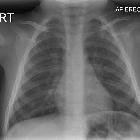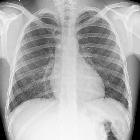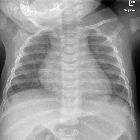Chest radiograph (pediatric)





The chest radiograph is one of the most commonly requested radiographic examinations in the assessment of the pediatric patient. Depending on the patients' age, the difficulty of the examination will vary, often requiring a specialist trained radiographer familiar with a variety of distraction and immobilization techniques.
Indications
Performing chest radiography on pediatric patients can be for a number of indications :
- respiratory disease (e.g. respiratory distress syndrome)
- cardiac disease
- bronchiolitis
- pneumonia
- pulmonary tuberculosis
- pneumothorax
- trauma
- foreign bodies
- septic screen
- confirming the location of line placement (e.g. PICC, ETT, NGT etc.)
Projections
Standard projections
As pediatrics vary in their level of cooperation, various projections can be utilized to suit the patient's needs and age:
- PA erect
- performed on older patients (teenage years), not advisable for younger patients due to their attention span (looking away from the 'camera' and everyone else can make for a very agitated child)
- AP erect
- ideal for cooperative younger children (i.e. between 3-7 years old) due to the ease of positioning and immobilization
- AP supine
- performed when imaging unconscious or uncooperative children
- AP supine (neonatal)
- performed mobile in the neonate unit
Additional projections
- lateral view
- not often performed in pediatrics
- can be used to highlight pathology in the mediastinum, costophrenic recess and localize lesions
- cross-table lateral view
- utilized in patients under the age of 6 months
- not often performed in pediatrics
- can be used to highlight pathology in the mediastinum, costophrenic recess and localize lesions
Patient preparation
Patients should remove any clothing and jewelry from waist up; particularly clothing with metal or shiny decorative material. Plaited hair should be untied .
Tips for pediatric chest radiography
Often difficulties in imaging the pediatric chest include:
- motion artifact
- insufficient inspiration
To overcome these, a variety of techniques can be used:
- distract the patient with toys, games and/or conversation
- perform immobilization with blankets and velcro straps
- use child-appropriate language (e.g. 'stand still like a soldier' and 'breathe in, you are about to go diving underwater!')
Immobilization techniques
Immobilization techniques will vary from department to department. A radiographer or parent being in the room with the patient holding them still has been cited as a commonly used technique in the Australian context. Other departments will make use of restraint devices, there is debate around the use of 'restraint' and if it fits the category of 'immobilization' .

